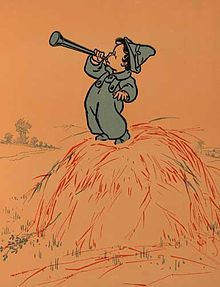Little Boy Blue
| "Little Boy Blue." | |
|---|---|
 1901 illustration by William Wallace Denslow | |
| Nursery rhyme | |
| Published | c. 1744 |
| Songwriter(s) | Unknown. |
| Composer(s) | ... |
| Lyricist(s) | ... |
"Little Boy Blue" is a popular English-language nursery rhyme, often used in popular culture. It has a Roud Folk Song Index number of 11318.
Lyrics
A common version of the rhyme is:
Little Boy Blue, come blow your horn,
The sheep's in the meadow, the cow's in the corn.
Where is that boy who looks after the sheep?
He's under a haystack, fast asleep.
Will you wake him? Oh no, not I,
For if I do, he'll surely cry.
Origins and meaning
The earliest printed version of the rhyme is in Tommy Thumb's Little Song Book (c. 1744), but the rhyme may be much older. It may be alluded to in Shakespeare's King Lear (III, vi) when Edgar, masquerading as Mad Tom, says:
Sleepest or wakest thou, jolly shepheard?
Thy sheepe be in the corne;
And for one blast of thy minikin mouth
Thy sheepe shall take no harme.[1]
It has been argued that Little Boy Blue was intended to represent Cardinal Wolsey, who was the son of an Ipswich butcher, who may have acted as a hayward to his father's livestock, but there is no corroborative evidence to support this assertion.[1]
References
- ^ a b I. Opie and P. Opie, The Oxford Dictionary of Nursery Rhymes (Oxford: Oxford University Press, 1951, 2nd edn., 1997), pp. 98–9.
- Child characters in literature
- Cattle in literature
- Fictional sheep
- Fictional shepherds
- Fictional musicians
- Songs about children
- Songs about musicians
- Songs about shepherds
- English nursery rhymes
- Roud Folk Song Index songs
- Songwriter unknown
- Year of song unknown
- 18th-century songs
- English folk songs
- English children's songs
- Traditional children's songs
